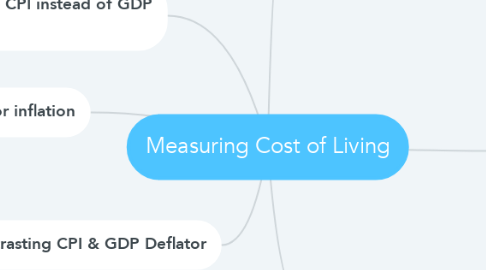
1. Contrasting CPI & GDP Deflator
1.1. Imported consumer goods
1.1.1. included in CPI
1.1.2. excluded from GDP deflator
1.2. capital goods
1.2.1. excluded from CPI
1.2.2. included in GDP deflator
1.2.2.1. if produced domestically
1.3. The basket
1.3.1. CPI uses fixed basket
1.3.2. GDP deflator uses basket of currently produced goods & services
1.3.3. This matters if different prices are changing by different amounts.
2. Correcting variables for inflation
2.1. Comparing dollar figures from different times
2.1.1. formula
2.1.2. 1
2.1.3. used to convert a time series of nominal figures into real figures.
2.1.4. can then see how a variable has changed over time after correcting for inflation.
2.2. Indexation
2.2.1. -
2.2.2. For example, the increase in the CPI automatically determines
2.2.3. the COLA in many multi-year labor contracts
2.2.4. adjustments in Social Security payments and federal income tax brackets
2.3. Real vs. nominal interest rates
2.3.1. Nominal
2.3.1.1. the interest rate not corrected for inflation
2.3.1.2. growth rate in dollar value of a deposit or debt
2.3.1.3. the rate we always hear about
2.3.2. Real
2.3.2.1. corrected for inflation
2.3.2.2. growth rate in purchasing power of a deposit or debt
2.3.2.3. the rate we never hear about
2.3.2.4. THE RATE THAT REALLY MATTERS!!!
2.3.2.5. Real interest rate = (nominal interest rate) – (inflation rate)
3. Why use CPI instead of GDP inflator?
3.1. Deflating wages by the CPI estimates how much consumption goods wages can buy
3.2. Deflating wages by the GDP deflator would estimate how much wages could buy of everything produced in the economy,
3.2.1. some of which is not suitable for consumption
4. Consumer Price Index (CPI)
4.1. CPI
4.1.1. measures the typical consumer’s cost of living
4.1.2. the basis of cost of living adjustments (COLAs) in many contracts and in Social Security
4.2. How calculated
4.2.1. Fix the “basket.”
4.2.1.1. The Bureau of Labor Statistics (BLS) surveys consumers to determine what’s in the typical consumer’s “shopping basket.”
4.2.2. Find the prices
4.2.2.1. The BLS collects data on the prices of all the goods in the basket.
4.2.3. Compute the basket's cost
4.2.3.1. Use the prices to compute the total cost of the basket.
4.2.4. Choose base year & compute the index
4.2.4.1. Choose a base year and compute the index.
4.2.5. Compute inflation rate
4.2.5.1. The % change in the CPI from the preceding period.
4.3. What's in basket"
4.3.1. basket
5. GDP Deflator
5.1. The GDP deflator is a measure of the overall level of prices.
5.2. One way to measure the economy’s inflation rate is to compute the % increase in the GDP deflator from one year to the next.
6. Problems with CPI
6.1. Substitution bias
6.1.1. Over time, some prices rise faster than others
6.1.2. Consumers substitute toward goods that become relatively cheaper,
6.1.2.1. mitigating the effects of price increases.
6.1.3. The CPI misses this substitution because it uses a fixed basket of goods.
6.1.4. Thus, the CPI overstates increases in the cost of living.
6.2. Introduction of New Goods
6.2.1. increases variety which allows consumers to find products that more closely meet their needs.
6.2.2. The CPI misses this effect because it uses a fixed basket of goods.
6.2.3. Thus, the CPI overstates increases in the cost of living
6.3. Unmeasured quality change
6.3.1. Improvements in the quality of goods in the basket increase the value of each dollar.
6.3.2. The BLS tries to account for quality changes but probably misses some, as quality is hard to measure.
6.3.3. Thus, the CPI overstates increases in the cost of living.
6.4. Due to above problems, CPI overstates inflation by about 0.5% per year
6.4.1. Soc. Security payments are computed using the CPI
